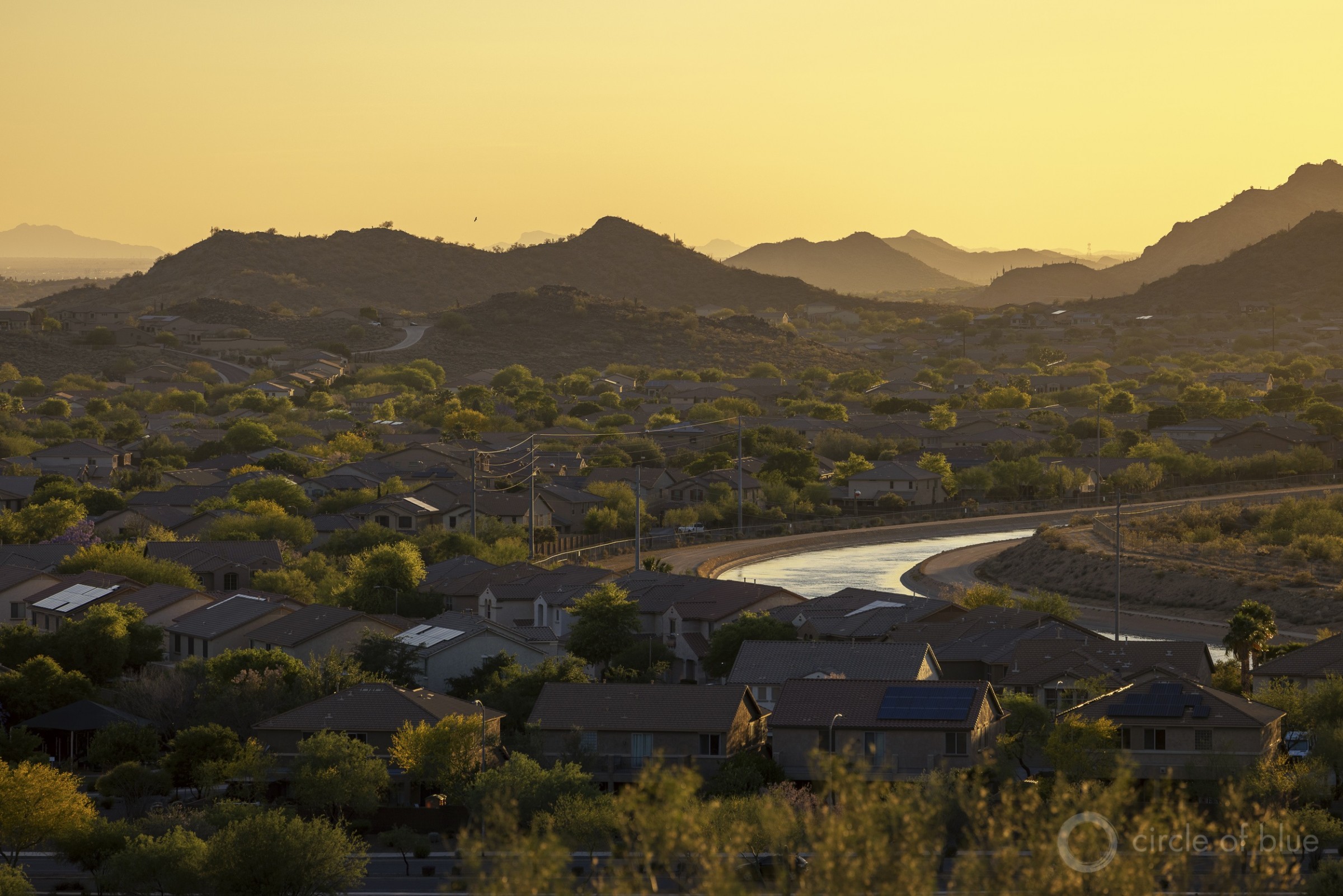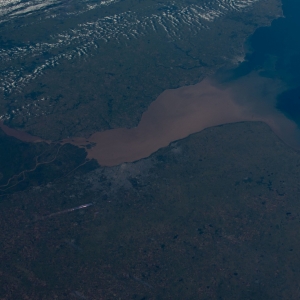Booming metro areas test the limits of water supply and growth.

Homes about the Central Arizona Project canal in Stetson Valley, a development about 20 miles north of downtown Phoenix. Photo © J. Carl Ganter/Circle of Blue
By Brett Walton, Circle of Blue – June 7, 2023
Mark Marlowe, who directs the water supply for fast-growing Castle Rock, a Denver suburb, has a dim view of lawns. Irrigating grass in summer consumes 40 percent of Castle Rock’s water. And unlike water used indoors, outdoor water cannot be recycled.
Marlowe is not reticent in articulating his disdain. Earlier this spring, he told a group of Colorado legislators, “I think of grass in Colorado as an invasive species — something we want to get rid of.”
In drawing a new battle line for providing water in his city of 80,000 residents, four times as many as in 2000, Marlowe is candidly attacking a residential amenity now viewed as an impairment that can be eliminated. “America has adopted grass,” Marlowe told the group. “We’ve done an amazing job of making the average person feel like if you don’t have a beautiful green Kentucky bluegrass lawn and a big mower, you haven’t made it in this country. It’s crazy.”
By no means is Marlowe’s attack on grass isolated. Water managers and elected officials across the American West are trying to undo that crazy as they reckon with the region’s existential confrontation: how to supply ever scarcer water to some of the nation’s fastest growing cities (Denver, Phoenix, Salt Lake City, Austin, San Antonio) and their even faster-growing outer-ring suburbs (Queen Creek, Arizona; Castle Rock, Colorado; Georgetown, Texas; Herriman, Utah). How, they ask, should a dry-region city grow? Or should steps be taken to limit growth?
Those are not idle questions in the West. On June 2, Arizona’s water agency determined that the Phoenix area does not have enough groundwater for all planned housing developments. The state Department of Water Resources will not certify new subdivisions in the area if they rely on local groundwater. Developers in Maricopa County must look elsewhere for a water supply.
The reason in Arizona, as in other dry western states, is that caution signs are flashing brightly. Colorado River reservoirs and the Great Salt Lake, though granted temporary reprieves following bountiful winter snows, have careened downward, plunging last year to record lows. Groundwater, a favored option for farms and developers alike, is often in no better condition.
Against this backdrop of gloom, though, a new narrative is taking shape in arid cities that are occasionally maligned for their very existence. In basic terms, the narrative is a counterproposal: cities have enough water as long as they conserve, reuse, stamp out leaks, and align their policies and cultures to the environmental contours of the drylands. The expansive Kentucky bluegrass lawn — Marlowe’s villain — must go extinct.
This is not a fantasy. In the last decade, western cities and their exurbs have truly opened their eyes to the possibilities, said John Berggren, a water policy analyst with Western Resource Advocates. Not only are they using less water. They are also weaving a water-wise ethic into the DNA of their municipal growth and development.
“There’s a growing recognition that there are actually ways to allow growth to happen, that don’t really increase the amount of overall water you need,” Berggren said. “That’s what more and more communities are looking to with landscape regulations, with zoning, with ordinances, with codes. We don’t have to restrict growth, we just have to shape it and make sure water efficiency is embedded throughout the entire development process.”
More People, Less Water
As Castle Rock’s water director, Marlowe is one of the local leaders at the center of these conservation debates. He’s been in the job for a decade now, leaving a similar position in humid Dalton, Georgia, in order to guide a growing city in a region with limited water. “I very much enjoy a challenge,” Marlowe told Circle of Blue.
Like a savvy financial planner, Castle Rock has embraced the portfolio approach to water. It uses water rates that penalize excessive use. It partners with neighboring cities on water reuse facilities. It is nudging homeowners to ditch lawns in favor of a “Colorado-scape” more suited to the local climate.
Years ago, metro areas approached the conservation challenge with financial inducements. Established cities like Las Vegas, Los Angeles, and Phoenix offered generous rebates — $3 or more per square foot — to homeowners to dig up their lawns and plant water-sipping alternatives like native shrubs or drought-tolerant grasses.
Such incentives helped these places cut per capita and total water use. Phoenix, despite adding more than a half million residents in the last three decades, today uses as much water as it did in the mid-1990s.

Builders frame new homes in Pinal County, Arizona. Photo © Keith Schneider / Circle of Blue
Peter Mayer, a water demand expert who runs the consulting company WaterDM, said cities still have lots of water savings to wring out. He cited data from Flume, a maker of smart water monitors, showing that efficient homes are below 30 gallons per person per day indoors. Those numbers are not a result of hyper-spartan lifestyles, he said. It’s a matter of detecting leaks and installing efficient fixtures and appliances.
“Nobody has changed their behavior,” Mayer told Circle of Blue. “We’re not seeing anything like that this requires military showers, or this requires three minute showers, that kind of thing. That’s just not the case. People basically can live their lives as they have been just with using less water to flush the toilet and wash the clothes and to leaks.”
Castle Rock offers a turf removal rebate of $1.50 per square foot. But retrofitting home landscaping — a piecemeal and comparatively expensive process — is less efficient than building smartly from the start, Marlowe said. That’s why the city changed its building codes.
Starting on January 1 of this year, a new ordinance went into effect in Castle Rock. New homes are not allowed to have grass in the front yard, and they are restricted to 500 square feet in the back. Marlowe reckons that the restrictions will allow Castle Rock to meet its long-term water conservation goal of 100 gallons per person per day. That conservation adds up to financial savings. Without the code change, Marlowe estimates the city would have to spend another $70 million in capital costs to acquire new water.
Castle Rock has company in using policy changes to target turf. In 2021, the Nevada Legislature allowed the Southern Nevada Water Authority, which serves the Las Vegas area, to prohibit “non-functional” turf — things like median strips and office park landscaping.
Those sentiments are echoed at the highest levels of state government. “Housing policy is water policy,” Colorado Gov. Jared Polis said at a University of Denver water law symposium in April. “Housing policy is climate policy.”
Homebuilders are getting on board with the idea that new homes should be much more efficient than older developments.
Castle Rock is collaborating with the homebuilding company Lennar to install greywater recycling systems in new homes. The systems, from a company called Greyter, repurpose water that goes down the shower drain for flushing toilets. John Bell of Greyter estimates that the system can cut indoor water use by 20 to 25 percent.
The new thinking is not confined to Castle Rock. Lennar has decided to eliminate irrigated turf in the front yards of all new homes it builds in Colorado by the end of 2024, according to Frank Walker, Lennar’s regional vice president for Colorado, Utah, and Arizona.
“We look at it as we have to help collectively solve the water issues in the West,” Walker told Circle of Blue.
Lennar is also the largest builder in Sterling Ranch, an eco-conscious development about 20 miles south of Denver that opened in 2018 and incorporates state-of-the-art water recycling, leak detection, and landscape design. Some 12,000 homes are expected at full buildout. According to Sterling Ranch, total indoor and outdoor water use among current residents is just 64 gallons per person per day, about half the use of many Front Range communities.
“It’s illustrative of what’s possible,” Berggren said about Sterling Ranch.
Market Incentives
Agriculture uses most of the water in the western states, and reducing farm demands is where the largest aggregate savings are to be found. For cities, conservation is often a financial equation. If they don’t conserve, it will cost them and their residents. The cheapest water was claimed years ago, and because of market forces buying or leasing more water will be shockingly expensive.
Castle Rock charges an impact fee of $42,000 per new home. The fee, based on the premise that “growth pays for growth”, helps secure water and wastewater services. Developers like Lennar can get up to a 40 percent discount if they meet strict criteria such as landscaping the front and back yards, in addition to installing greywater systems, efficient washing machines, toilets, and faucets.
Costs are mounting in Arizona, too. Queen Creek, an exurb 35 miles southeast of Phoenix, budgeted $168 million in 2023-24 to acquire new water supplies.
Queen Creek’s population soared from just under 4,000 two decades ago to roughly 70,000 today. Due to market shifts, builders are no longer offering lawns. “The days of having turf when it’s only ornamental and looks nice are gone,” Paul Gardner, the city water resources director, told Circle of Blue.
About 9,000 unbuilt homes in Queen Creek are affected by the state’s declaration of insufficient groundwater in the Phoenix area for new development, Gardner says. Queen Creek will now look farther afield for water to serve these homes. One option is groundwater from Harquahala Valley some 80 miles to the west, which is not subjected to the recent restrictions.
As these fast-growing areas expand, the contours of the new conservative ethic will rumble across uneven terrain. Some westerners hesitate to abandon a pastoral suburban life just to add more people.
At a Nevada Senate hearing on May 16, state Sen. Ira Hansen questioned the end-logic of the conservation trajectory. A limits-to-growth approach, an essential facet of 1970s environmentalism, might seem odd coming from a Nevada Republican. But when it comes to satisfying demand for water the politics of solving real risks to well-being take hold.
“I realize I’m committing heresy by even daring to bring up the idea that maybe it’s time we look at restricting endless growth in the state of Nevada in areas that frankly don’t have the resources to do it,” Hansen said.
An earlier version of this article incorrectly stated that Queen Creek had banned turf in front and back yards. Builders are just not offering it.
Brett writes about agriculture, energy, infrastructure, and the politics and economics of water in the United States. He also writes the Federal Water Tap, Circle of Blue’s weekly digest of U.S. government water news. He is the winner of two Society of Environmental Journalists reporting awards, one of the top honors in American environmental journalism: first place for explanatory reporting for a series on septic system pollution in the United States(2016) and third place for beat reporting in a small market (2014). He received the Sierra Club’s Distinguished Service Award in 2018. Brett lives in Seattle, where he hikes the mountains and bakes pies. Contact Brett Walton




